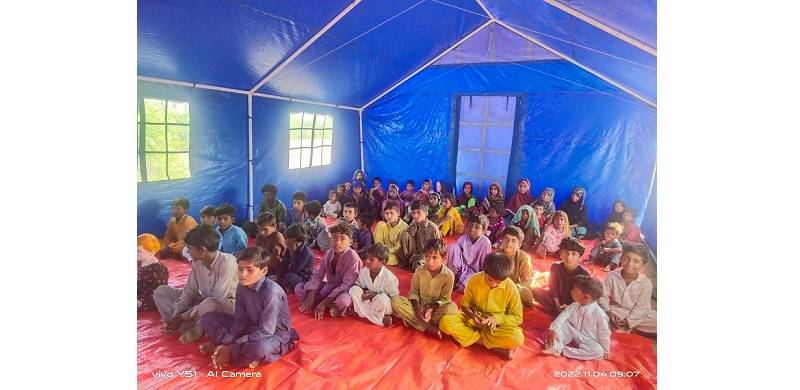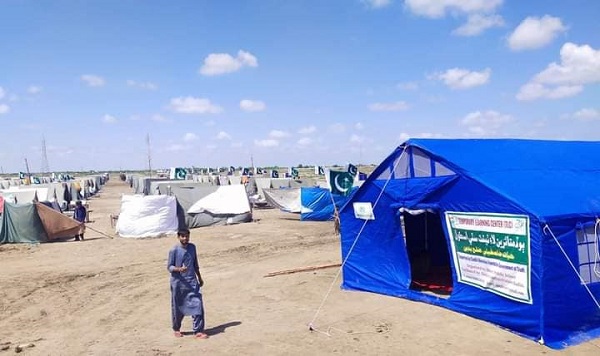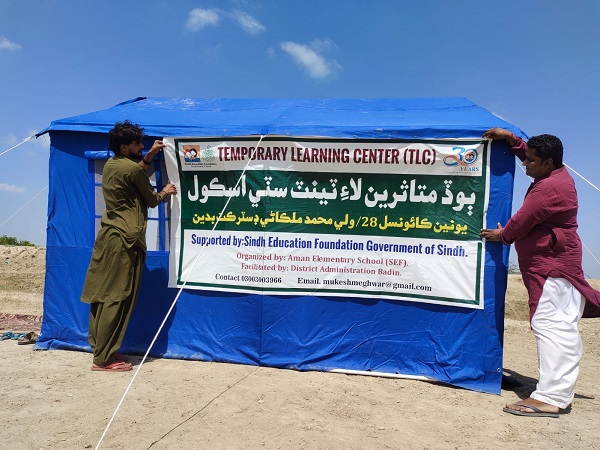
Ganga Bai, 10, in a blink of an eye, had lost her home, childhood, books, pencils, toys, and almost everything. It was a shocking moment and an unbearable loss for her. When Ganga lost her Hajo Patel school for a while, she was scared about her education, but as she and her other family members temporarily settled down in the flood relief camp, she observed a little ray of hope that she would get classes again in school.
"I want to read, write and play but my school and playground are inundated with flood water for more than four months," Ganga says with grief. “We were helpless, my makeshift home damaged before my eyes." She stated that her father had made it with hard work: he earned the money from farming and saved penny by penny for this home.
Pakistan is experiencing weather change patterns for the last two decades, and this year unexpectedly rainfall has hit the country. As a result, Sindh and Balochistan provinces were more affected by the disastrous floods. The Sindh government has declared 23 districts to be calamity-hit in Sindh, including district Badin.
During the flood, a group of volunteers, consisting of three friends, had established the temporary learning center (TLC) in union council Wali Mohmmad Malkani, 61 km away from the district headquarter Badin, to continue the education of climate-induced flood-affected children in Badin. Mostly these children hail from the poor and working-class families.
Ram Kolhi is a social worker and founder of this initiative, who has offered an opportunity for school less children during floods. He and his entire team had brought the children back to school.
According to the education department of Sindh, 2,500 schools have been transformed into relief camps. “It was a very difficult task but despite the hurdles, I and my friends have done it for the betterment of children, '' says Ram. “We had set up tent schools for the two months in three different spots in the area.”
Ashok Kumar son of Mano Mal, 11-year -old, studying in fifth grade, belongs to the village Nabisar Morr, Jhudo. He says, "My school was underwater since the flood had hit the village. It was not easy for me and my family to leave the village, but conditions were not in our favour," says Kumar. "I enrolled in the tent school in Malkani and I got education with proper guidance."
Ashok's tent school fellow Arjun son of Nursing has been also displaced by floods. Arjun, 12, hails from near Nabisar road. He is enrolled in sixth class at the Marriyum Foundation School. However, when he left the native school along with other classmates, his dreams were drowned – but as soon as possible he got back to his education again in the tent school, and he was happy. “When I entered the tent school the first time, I was scared, because it was my first experience, I never faced such a situation before," he says, a little smile clear on his face.
 Amid the global climate crisis, flood and flood-like situations have made children the most vulnerable group on the planet. All over the world, but especially in Pakistan, children are combating the consequences of climate change and paying a huge price every year. According to UNICEF, around 16 million children have been badly affected by this year in Pakistan. Over 27 million children are at risk as unprecedented floods set records across the world.
Amid the global climate crisis, flood and flood-like situations have made children the most vulnerable group on the planet. All over the world, but especially in Pakistan, children are combating the consequences of climate change and paying a huge price every year. According to UNICEF, around 16 million children have been badly affected by this year in Pakistan. Over 27 million children are at risk as unprecedented floods set records across the world.
Kolhi says that after the flood, they established four temporary learning centers (TLC) separately for both boys and girls in different areas, where relief camps were set up by the government of Sindh. He explains that one TLC was established in the villages Ameer Bux Chandio and Sadiq Chandio, where 55 and 62 students respectively were enrolled. And another one was set up in the Mubarak Khoso village, where 89 students were in primary education. Additionally, we have been successful in establishing one more tent school in the Khema Basti Hayat Khaskheli, where 80 students were exercising their education rights.
Ram speaks in detail about the funding that three friends spent from their own pockets. "We spent 60,000 rupees for teachers' salaries, 80,000 rupees for sports material, 30,000 rupees for stationery, and 40,000 rupees for transport, etc." He adds, “Our aim was to protect the children's education from being affected, now the children have returned to government schools. So, we who are running Sindh Education Foundation schools and will continue with this platform.”
In the constitution of Pakistan, article 25-A ensured that education is the fundamental right of every child in the country. But various studies reveal that millions of children are out of school – in fact, they do not have proper access to schools. Presently, in Sindh, more than 50 percent of the poorest children, including 58 percent of girls, are not enrolled in schools, according to UNICEF. Globally, Pakistan has the second-highest number of out-of-school children, with around 22.8 million children aged 5-16.
Ajmal, 30, was a member of Ram's team and he was supporting the entire process as a volunteer. He was working for the Sindh education foundation school, set up 5 km far away from the city Malkani. However, this year, in the monsoon season, when heavy rains turned into flash floods, he was involved in relief activity.
All private teachers were hired on an Rs.10,000 salary for two months. There was a single volunteer teacher for every tent school, except Ameer Bux center, where there was a government teacher. Ashfaq Ahmed was the teacher on contract basis at the government-shifted tent school near Malkani. His experience has been fantastic because it was a healthy opportunity for him to do something for affected children. Consequently, Ashfaq engaged in teaching since the tent school was established.
“It was a super learning experience, and we faced challenges, but the overall experience was really well nourished," shares Ashfaq. "It was a memorable time, and I can't forget it.”
Mukesh Meghwar is a social activist working in the development sector since 2010. He has been a team member in the volunteer group during the floods.
Meghwar criticises the government and says that they have done nothing on the ground except press statements. Bansi Malhi, a development professional working for the International Rescue Committe (IRC), Pakistan, says “Children have suffered psychologically and physically. It was a big trauma for them, they urgently need psychotherapy sessions.”
According to Pakistan's monthly climate summary produced by Pakistan Meteorological Department, August has been an extremely excessively rainy month in 2022. It was +243 percent above average since 1961. The climate change ministry in Pakistan reports that more than 33 million people have been affected and 1,700 people have lost their lives across the country.
In a session of the Sindh Assembly, Education Minister Syed Sardar Shah, while sharing the data due to the unusual monsoon rains and floods, says that more than 20,000 schools were damaged across the province and more than 230,000 children were deprived of schooling.
In 2020, during the Corona pandemic for more than two years, the education sector has already suffered badly in Pakistan. On top of that, again floods have pressed young students into the worst of conditions.
District Education Officer (EDO) Primary Salih Korijo says that the flood has wrecked the education sector and it has affected the education of children. More than 80 percent of school infrastructure has been destroyed in flood-hit union councils including Malkani Sharif, Khairpur Ghambu, Syed Saman Sarkar, and Pirbodlo.
Stating the numbers, he says that 52 percent of the schools have been dysfunctional, and 50 percent of them have been badly damaged. "We desperately need furniture and reconstruction of the schools," Korijo says. “Now children have gone back to their schools, and 30 to 40% of enrolment is improved, after the appointment of fresh teachers in 2022," he adds.
Ram emphasises that federal and provincial governments should review and update the primary to matric level syllabus.
“Education for children was our main concern. t was really a big achievement for us that we have tried to ensure education for flood-affected children," says Kolhi, smiling. “Although it was a little effort for school children, our team was satisfied that we, at least, tried and did not give up.”
"I want to read, write and play but my school and playground are inundated with flood water for more than four months," Ganga says with grief. “We were helpless, my makeshift home damaged before my eyes." She stated that her father had made it with hard work: he earned the money from farming and saved penny by penny for this home.
Pakistan is experiencing weather change patterns for the last two decades, and this year unexpectedly rainfall has hit the country. As a result, Sindh and Balochistan provinces were more affected by the disastrous floods. The Sindh government has declared 23 districts to be calamity-hit in Sindh, including district Badin.
During the flood, a group of volunteers, consisting of three friends, had established the temporary learning center (TLC) in union council Wali Mohmmad Malkani, 61 km away from the district headquarter Badin, to continue the education of climate-induced flood-affected children in Badin. Mostly these children hail from the poor and working-class families.
Ram Kolhi is a social worker and founder of this initiative, who has offered an opportunity for school less children during floods. He and his entire team had brought the children back to school.
According to the education department of Sindh, 2,500 schools have been transformed into relief camps. “It was a very difficult task but despite the hurdles, I and my friends have done it for the betterment of children, '' says Ram. “We had set up tent schools for the two months in three different spots in the area.”
Ashok Kumar son of Mano Mal, 11-year -old, studying in fifth grade, belongs to the village Nabisar Morr, Jhudo. He says, "My school was underwater since the flood had hit the village. It was not easy for me and my family to leave the village, but conditions were not in our favour," says Kumar. "I enrolled in the tent school in Malkani and I got education with proper guidance."
Ashok's tent school fellow Arjun son of Nursing has been also displaced by floods. Arjun, 12, hails from near Nabisar road. He is enrolled in sixth class at the Marriyum Foundation School. However, when he left the native school along with other classmates, his dreams were drowned – but as soon as possible he got back to his education again in the tent school, and he was happy. “When I entered the tent school the first time, I was scared, because it was my first experience, I never faced such a situation before," he says, a little smile clear on his face.
 Amid the global climate crisis, flood and flood-like situations have made children the most vulnerable group on the planet. All over the world, but especially in Pakistan, children are combating the consequences of climate change and paying a huge price every year. According to UNICEF, around 16 million children have been badly affected by this year in Pakistan. Over 27 million children are at risk as unprecedented floods set records across the world.
Amid the global climate crisis, flood and flood-like situations have made children the most vulnerable group on the planet. All over the world, but especially in Pakistan, children are combating the consequences of climate change and paying a huge price every year. According to UNICEF, around 16 million children have been badly affected by this year in Pakistan. Over 27 million children are at risk as unprecedented floods set records across the world.Kolhi says that after the flood, they established four temporary learning centers (TLC) separately for both boys and girls in different areas, where relief camps were set up by the government of Sindh. He explains that one TLC was established in the villages Ameer Bux Chandio and Sadiq Chandio, where 55 and 62 students respectively were enrolled. And another one was set up in the Mubarak Khoso village, where 89 students were in primary education. Additionally, we have been successful in establishing one more tent school in the Khema Basti Hayat Khaskheli, where 80 students were exercising their education rights.
Ram speaks in detail about the funding that three friends spent from their own pockets. "We spent 60,000 rupees for teachers' salaries, 80,000 rupees for sports material, 30,000 rupees for stationery, and 40,000 rupees for transport, etc." He adds, “Our aim was to protect the children's education from being affected, now the children have returned to government schools. So, we who are running Sindh Education Foundation schools and will continue with this platform.”
In the constitution of Pakistan, article 25-A ensured that education is the fundamental right of every child in the country. But various studies reveal that millions of children are out of school – in fact, they do not have proper access to schools. Presently, in Sindh, more than 50 percent of the poorest children, including 58 percent of girls, are not enrolled in schools, according to UNICEF. Globally, Pakistan has the second-highest number of out-of-school children, with around 22.8 million children aged 5-16.
Ajmal, 30, was a member of Ram's team and he was supporting the entire process as a volunteer. He was working for the Sindh education foundation school, set up 5 km far away from the city Malkani. However, this year, in the monsoon season, when heavy rains turned into flash floods, he was involved in relief activity.
All private teachers were hired on an Rs.10,000 salary for two months. There was a single volunteer teacher for every tent school, except Ameer Bux center, where there was a government teacher. Ashfaq Ahmed was the teacher on contract basis at the government-shifted tent school near Malkani. His experience has been fantastic because it was a healthy opportunity for him to do something for affected children. Consequently, Ashfaq engaged in teaching since the tent school was established.
“It was a super learning experience, and we faced challenges, but the overall experience was really well nourished," shares Ashfaq. "It was a memorable time, and I can't forget it.”
Mukesh Meghwar is a social activist working in the development sector since 2010. He has been a team member in the volunteer group during the floods.

Meghwar criticises the government and says that they have done nothing on the ground except press statements. Bansi Malhi, a development professional working for the International Rescue Committe (IRC), Pakistan, says “Children have suffered psychologically and physically. It was a big trauma for them, they urgently need psychotherapy sessions.”
According to Pakistan's monthly climate summary produced by Pakistan Meteorological Department, August has been an extremely excessively rainy month in 2022. It was +243 percent above average since 1961. The climate change ministry in Pakistan reports that more than 33 million people have been affected and 1,700 people have lost their lives across the country.
In a session of the Sindh Assembly, Education Minister Syed Sardar Shah, while sharing the data due to the unusual monsoon rains and floods, says that more than 20,000 schools were damaged across the province and more than 230,000 children were deprived of schooling.
In 2020, during the Corona pandemic for more than two years, the education sector has already suffered badly in Pakistan. On top of that, again floods have pressed young students into the worst of conditions.
District Education Officer (EDO) Primary Salih Korijo says that the flood has wrecked the education sector and it has affected the education of children. More than 80 percent of school infrastructure has been destroyed in flood-hit union councils including Malkani Sharif, Khairpur Ghambu, Syed Saman Sarkar, and Pirbodlo.
Stating the numbers, he says that 52 percent of the schools have been dysfunctional, and 50 percent of them have been badly damaged. "We desperately need furniture and reconstruction of the schools," Korijo says. “Now children have gone back to their schools, and 30 to 40% of enrolment is improved, after the appointment of fresh teachers in 2022," he adds.
Ram emphasises that federal and provincial governments should review and update the primary to matric level syllabus.
“Education for children was our main concern. t was really a big achievement for us that we have tried to ensure education for flood-affected children," says Kolhi, smiling. “Although it was a little effort for school children, our team was satisfied that we, at least, tried and did not give up.”

